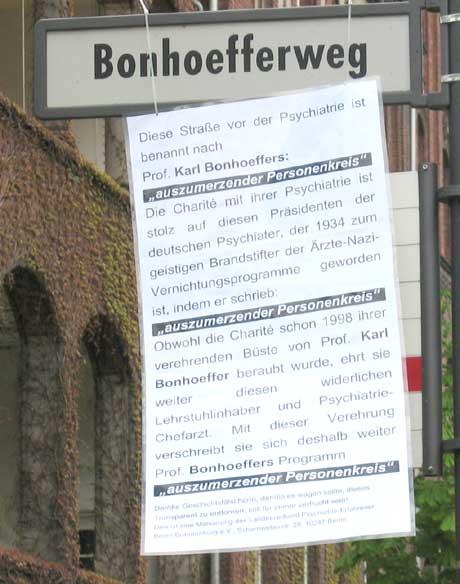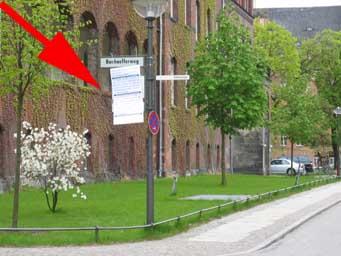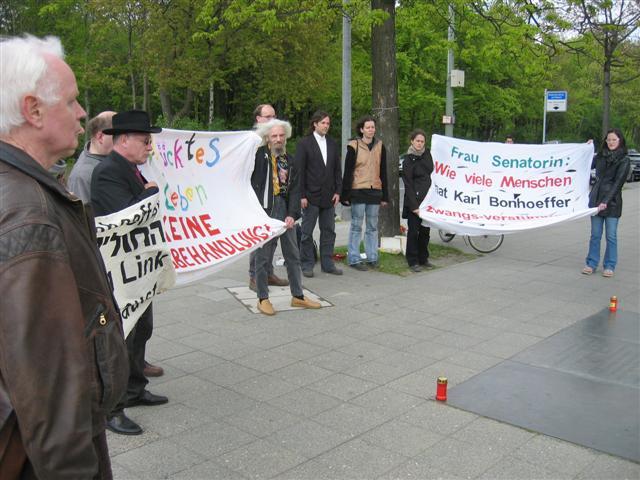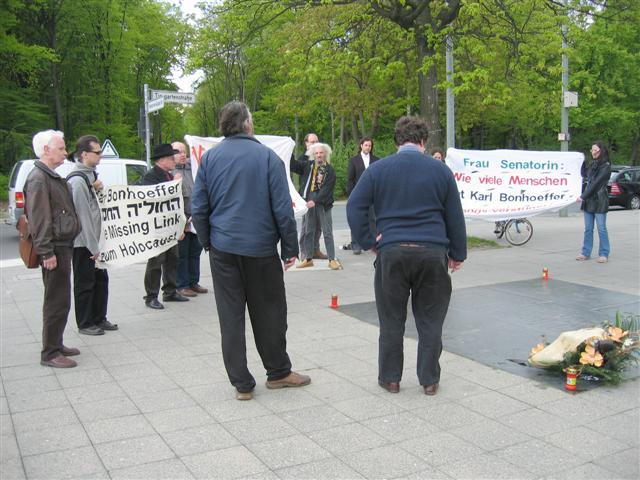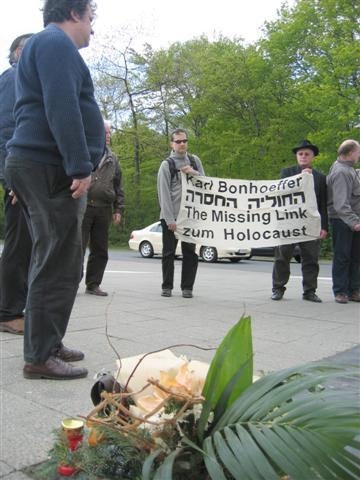International Commemoration 2006
Berlin (see below) - Amsterdam (click here)
Permanent commemoration: Names of victims 1939 - 1945
Dieses Jahr 2023: Berlin 2022: Berlin 2021: Berlin 2019-2020: Berlin 2018: Berlin 2017: Berlin 2016: Berlin 2015: Berlin 2014: Berlin 2013: Berlin 2012: Berlin 2011: Berlin 2010: Berlin 2009: Berlin 2008: Berlin 2007: Berlin 2006: Berlin - Amsterdam International Commemoration 2006
Berlin (see below) - Amsterdam (click here)
Permanent commemoration: Names of victims 1939 - 1948Click here for the "Freedom from Fear" tour in 1999 to visit areas where exterminations took place in hospitals located in different parts of Germany.
Click here for the international "Foucault Tribunal" which took place on May 2nd 1998 in Berlin. As a reference to this event the R&R Day is on the 2nd of May.
This sign was hung in front of the psychiatric department of Berlin's largest hospital.
Our R & R demonstration ended on the street outside it, because the hospital bosses prohibited us from entering it. They were afraid of the truth translated here:
This street in front of the psychiatric ward is named after Prof. Karl Bonhoeffer's "group of people to be exterminated". The Charité Hospital with its psychiatric ward is proud of this President of German Psychiatrists who in 1934 became the intellectual arsonist of the doctor-Nazi extermination program by writing: "group of people to be exterminated". Although the Charité was robbed of its venerated busts of Prof. Karl Bonhoeffer, it continues to honour this disgusting tenured professor and senior physician of psychiatry. By this glorification it continues to dedicate itself to Prof. Bonhoeffer's program of a "group of people to be exterminated."
The Regional Organization of Psychiatry Survivors Berlin-Brandenburg and
the Federal Working Group of Psychiatric Survivors:
Announcement of the 12th T4 Demonstration on May 2, 2006
in memory of the victims of the National Socialist's psychiatry and their accomplicesMay 2 is the international day of commemoration of the crimes of Nazi psychiatry and their accomplices and the Day of Resistance Against Coercive Psychiatry. In Berlin we therefore also remember the victims of the medical mass murder. Here from 1939 onwards began the so-called 'Aktion T4' in the gas chambers of the psychiatric institutions and later by poison syringes and forced starvation up to the year 1948, leading to the death of approx. 300,000 individuals. We likewise remember the victims of psychiatry before 1939 who were tormented, forcibly sterilized and murdered and also those, who (still) today in the psychiatric institutions and also outside of them are tormented, harmed, slandered and robbed of their liberty because of a so-called diagnosis. Thus forced psychiatric treatment will be never an assistance, but rather always is a crime.
The demonstration procession begins on May 2, 2006 around 2 p.m. at the memorial placque in the Tiergartenstrasse 4 near the entrance of the Philharmonic Concert Hall. After the solemn wreath-laying ceremony it proceeds to the Charité Hospital, before which the closing speech is to take place at about 3:30 p.m..
The choice of the destination, the Charité Hospital Clinic, is not arbitrary: Despite halfhearted efforts and promises, Karl Bonhoeffer obviously continues to be admired by the Charité Hospital and at the same time the promises by the Chief Physician, Andreas Heinz, to guarantee the right of self-determination of current patients of psychiatry in the Charité Hospital have been broken.
Karl Bonhoeffer was employed as Clinic Director at the Charité Hospital from 1912 to 1938 and was also on the Chair for Psychiatry and Neurology at the Berlin University and participated as a consultant and as a judge in the Nazi Hereditary Health Upper Court in forced sterilization procedures. Also after his retirement he was active as an expert and in publishing and furthermore in August 1942 he was appointed by the National Socialists as extraordinary member of the scientific senate of the army medical services.
In 1998 already it was confirmed by a motion by the Green Party in the Berlin senate that Karl Bonhoeffer participated in his responsible position as a judge and consultant in at least 55 sterilization procedures, leading to at least 26 forced mutilations. Moreover, it was under Bonhoeffer's management at the Charité Hospital, from where thousands were registered, examined and a large number of them thereupon forcibly sterilized. For this too Bonhoeffer carries a responsibility, as the medicine historian Thomas Beddies, who last year was even invited to a function at the Charité Hospital (see below) to make a speech - also points out: "Bonhoeffer himself put value on the statement that he always knew what took place in his hospital and was always also informed about the tenor of the appraisals written in his hospital " (Beddies, Thomas: University Psychiatry in the Third Reich. The mental hospital of the Charité Hospital under Karl Bonhoeffer and Maximinian de Crinis. In: vom Bruch, Ruediger (Publishers.): The Berlin University in the Nazi era. Volume II: Specialist areas and faculties. Franz Steiner publishing house: Stuttgart 2005, Page 60).
Bonhoeffer neither rejected sterilization, nor did he work convincingly against the obligatory enforcement of it but rather saw himself as only being responsible for 'psychiatric scientifically' based diagnostic as a basis for sterilization.Karl Bonhoeffer can be seen as the 'missing link' to the Holocaust: He was the link between contemporary psychiatry at that time, which is still valid up to today, as well as the murderous actions of the Nazis, since he participated among other things in the forced sterilizations in which the Nazi system participated and on the basis of his 'diagnoses' people were selected for the Nazis' murderous actions. And seen on another level, Karl Bonhoeffer can be regarded as the intellectual arsonist, because in his writings he used the race-biologistic jargon of the National Socialists and their forerunners and shared their contemptible ideology.
For example he pondered over "the border between a hereditary-biologically harmless debility and an imbecility which surely can be eradicated" (see "The psychiatric tasks during the execution of the law for preventing a hereditary ill new generation", Berlin, March 1934). There is also mention of a another example, namely his survey "A contribution to the knowledge of the begging and vagabonding in large cities" from the year 1901, which at the time and still today supports the fashionable pathologizing of poverty and deviating behavior and feeds the representatives of the murderous image of those "unworthy of life".
In this pamphlet Bonhoeffer speaks of the "inferiority (...) in the psychological field", of "innate imbecility" and "innate psychologically defectual conditions" (Magazine for criminological science. Volume 21. J. Guttentag publishing house: Berlin 1901, p. 22). Beddies concludes as follows: "In the decades before the seizing of power by the Nazis, Karl Bonhoeffer, like many of his colleagues, had already considered plausible and recognized as serious the Therory of Eugenics, i.e. the improvement of the innate characteristics of a race, as well as their practical conversion in the sense of selection and exclusion of inferior hereditary genes from reproduction. Besides incarceration in an institution, marriage prohibition and abortion, in principle also sterilization was seen as a suitable possibility for intervention in order to counter a degradation of the collective hereditary genes. During his life-time Bonhoeffer did not waver from this basic attitude." (Beddies 2005: p.71).
Despite protests for many years there is still a "Bonhoeffer Way" on the campus of the Charité Hospital in Berlin which passes directly in front of the psychiatric department! - and a Bonhoeffer lecture-room. In addition, the state, business and psychiatric officials remain steadfast in the naming of the underground and regional train stations and the institution as the "Karl-Bonhoeffer-Mental-Clinic".
On February 3, 2005 the Charité Hospital announced an invitation to a discussion "Disputes - Bonhoeffer and the consequences". Apart from the scandal that the criminal Karl Bonhoeffer was to be "controversially discussed", as mentioned there were also speeches which openly publicized the crimes. Afterwards one could read on the Charité Hospital's website: "It stands to debate, according to Andreas Heinz, chief of the Psychiatric and Mental Clinic of the Charité Hospital, how these designations are to be commented in the future, whether by a memorial, exhibitions or information boards or whether a renaming is recommended." (www.charite.de/psychiatrie/forschung/Beddies_Bonhoeffer_Summary.pdf)
Since these hollow clichés over a year ago, nothing has happened. For Mr. Heinz, who currently occupies Bonhoeffers' position, these promises seem to count just as little as those which he made regarding the patients of his psychiatric torture chamber, i.e. those who sit in the locked ward at the "Bonhoeffer Way", lying down (with four-point restraint) or who walk back and forth as a result of being motor-impaired by the psycho-pharmacological drugs. Heinz, on being questioned on this, declared that the treatment "would be arranged according to the will of the patient or his/her guardian, in as far as this is legally permissible" (see Huch! No.44, July 2004, Newspaper of the student autonomy and of the Humboldt University of Berlin).
In fact after this promise, for example, in an appraisal a female patient of the Charité Hospital was actually deprived of her legal competency retroactively for four years and forcibly treated in the closed ward. (www.psychiatrie-erfahrene.de/io12/stiefel.htm)
May 2, 2006. At the beginning of our demonstration, in memory of the medical mass murder in Germany under National Socialism, a bouquet of flowers was laid on the T4 memorial placque and a minute of silence was held:
Translation of the inscription on the wreath: "For our murdered sisters and brothers."
From "The Psychiatric Survivors and Lunatic Offensive."
We walk through the famous Brandenburg Gate and demonstrate in front of it and make a short speech.
